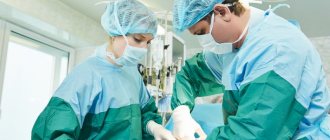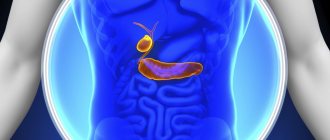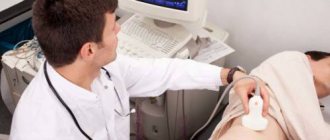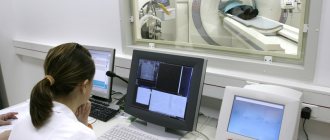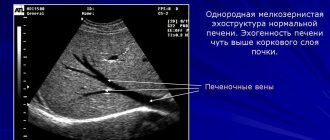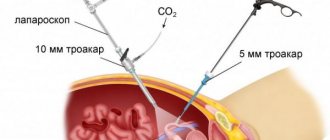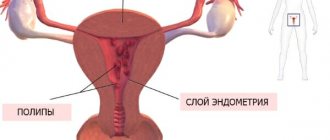After abdominal surgery (laparotomy)
Abdominal surgery or laparotomy is prescribed for people with a severe form of gallbladder disease that occurs with complications. During the operation, a large incision is made through the right hypochondrium, followed by displacement of organs and tissues to gain access to the gallbladder.
To prevent postoperative complications, it is recommended to wear a bandage that tightly secures the anterior abdominal area and significantly reduces the load on the operated area.
A bandage after removal of the gallbladder using a laparotomy incision helps to avoid suture dehiscence, as well as the formation of a postoperative hernia. In addition, after such an operation painful sensations are added, and a dense product helps reduce their intensity. Another advantage is the fact that thanks to the medical bandage, the scars become more elastic and less noticeable.
After laparoscopy
Laparoscopy —
a modern method of surgery in which internal surgery is performed through small (usually 0.5-1.5 cm) holes, while traditional surgery requires large incisions.
The laparoscopic method of surgical intervention is less traumatic and occurs without displacement of organs. The question of whether it is necessary to wear this product in this case causes disagreement among experts. However, most of them claim that a bandage after laparoscopy is necessary in order to tone the abdominal muscles and reduce discomfort in the first days after surgery.
The duration of the temporary period is determined by the attending physician, taking into account factors such as the patient’s age, his weight, existing chronic diseases, as well as general well-being after the operation. For young people who do not have serious health problems, the period of wearing a fixation product is from 2 to 3 months. Elderly patients, especially those who are overweight, are recommended to wear the brace for about 6 months.
In this case, the elastic bandage is not worn for a long time, since laparoscopic punctures heal much faster than incisions. Using a support bandage helps prevent inflammation, as the fabric creates an obstacle for germs to enter the wound. Therefore, wearing a bandage after removal of the gallbladder by laparoscopy will be enough from one week to a month.
To get a positive result from a support bandage, you must follow some recommendations:
- The product is put on immediately on the first day when the patient is allowed to stand on his feet, since the first days are especially dangerous in terms of complications.
- The correct size must be selected.
- It is necessary to put it on correctly so that there is no discomfort.
- It is advisable to remove the bandage during daytime or nighttime sleep to avoid excessive pressure on the abdominal area, which can adversely affect the cardiovascular system by impairing blood circulation.
- In order not to impede the penetration of air into the operated area, the clamp should not be tightened too much.
Electrophoresis and physiotherapy during the recovery period
Physiotherapy is required due to gynecological operations on the following organs:
After treatment of fallopian tube obstruction, the following physiotherapy procedures are performed:
- compresses made of ozokerite or paraffin;
- medicinal electrophoresis.
Based on the results of treatment of the ovaries, removal of myomatous nodes and enlarged endometrium, in addition to electrophoresis, magnetic therapy is used.
Physiotherapeutic methods are used to prevent adhesions from forming after laparoscopy.
Physiotherapy is not required after diagnostic laparoscopy.
Retaining fasteners
It is necessary that the Velcro be of high quality, which will ensure reliable fixation.
It is better to carry out the first fitting with your attending physician, who will tell you the required degree of tightening.
Read other articles on the topics:
A medical bandage requires proper care:
- Can only be washed by hand at a water temperature of no more than 40 degrees.
- Rinse the bandage well under running water.
- It is recommended to dry the product at room temperature and flattened.
- The bandage must be stored in a place protected from moisture and direct sunlight.
- Washing, spinning and drying the elastic bandage in a washing machine is not allowed.
- Do not use bleaching agents.
- Cannot be ironed.
A bandage after removal of the gallbladder will help speed up the healing of sutures and significantly shorten the rehabilitation period. Also, making the right choice and following all the necessary recommendations for using the product will significantly speed up the healing process and make it less painful.
Cholecystectomy (as surgery to remove the gallbladder is called in medicine) is prescribed in cases of severe cholelithiasis, usually occurring against the background of acute or chronic calculous cholecystitis. Modern surgery offers two methods of performing such surgical intervention - laparoscopy and traditional abdominal removal.
Whatever method of surgical intervention is used, the patient must in any case undergo a certain rehabilitation period in order to restore the functions of the operated body without any complications. During the recovery period, it is necessary to follow a number of medical recommendations, one of which is wearing a special medical bandage after cholecystectomy.
Video
Recovery after laparoscopy takes from 2 to 4 weeks, depending on the severity of the manipulation and the development of any complications. The main thing is to create conditions in the early postoperative period to prevent the formation of adhesions in the pelvis, especially if they existed before the procedure.
Features of recovery after laparoscopy
Wearing a bandage after abdominal surgery
Open cholecystectomy (laparotomy) is currently used to remove this organ only in exceptional cases, when operating on patients with severe cholelithiasis, aggravated by associated complications, as well as in cases where laparoscopy is contraindicated for the patient for some reason. In all other cases, the laparoscopic technique is used, which is less traumatic and allows for a faster recovery.
During laparotomy, a large incision is made in the area of the right hypochondrium, then tissues and organs are forcibly moved to the side to gain access to the operated organ, which is excised along with the nearest vessels and bile ducts.
To avoid inflammation and remove postoperative fluids, drainage is placed and the surgical wound is sutured. Of course, rehabilitation after such an intervention lasts much longer and is more difficult than after laparoscopy of the gallbladder. In addition, the risk of complications after abdominal surgery is much higher.
Such complications include:
- injury to nearby blood vessels;
- the occurrence of bleeding from the artery of the bladder;
- entry of bile into the abdominal organs;
- the risk that the seams may come apart;
- suppuration of the surgical wound;
- the appearance of a hernia after surgery, and so on.
To minimize the risk of complications after gallbladder laparotomy, the surgeon strongly recommends (and even obliges) the patient to wear a support bandage, which secures the anterior abdominal wall well and significantly reduces the load on the operated part of the body.
This allows, even in the case of insufficiently qualified suturing of the surgical wound, to prevent the sutures from coming apart and the appearance of a postoperative hernia. In addition, any tension in the abdominal cavity after such an operation causes pain, and a tight bandage, which is the bandage, significantly reduces its intensity. And finally, wearing a medical bandage allows the postoperative scar to gradually become an elastic and inconspicuous scar.
Duration of wearing such a bandage after abdominal surgery
Many operated patients ask the question: “How long should I wear a bandage after gallbladder removal?” The duration of this time period is usually prescribed by the attending physician, taking into account factors such as the patient’s age, gender and body weight, whether he has chronic diseases, and also based on the general physical condition of the patient after cholecystectomy.
Typically, physically healthy and young patients wear this retainer for two to three months. If the patient is obese and overweight, has a sagging belly, then he should wear such a product for fixing the abdominal cavity for at least six months, or even seven months, periodically removing it in a calm environment to avoid the appearance of diaper rash.
On the other hand, it is also impossible to exceed the period of wearing the bandage recommended by the doctor, since in such cases muscle atrophy and atrophy of the ligaments located in the abdominal cavity develop.
Bandage after laparoscopic gallbladder removal
With the laparoscopic surgical procedure, the surgeon makes 4 small punctures (one centimeter in diameter) in the abdominal area. Then, through them, the doctor inserts a video camera and special instruments into the surgical area, and with their help completely removes the gallbladder. As you can see, such a surgical intervention is much less traumatic (compared to laparotomy), and the surrounding internal organs are not affected.
The rehabilitation period after cholecystectomy performed in this way is much shorter (for example, the patient is usually discharged from the hospital on the second to fourth day after the operation). Laparoscopy also minimizes the risk of adhesions, hernias and other postoperative complications.
Is a bandage needed after gallbladder laparoscopy? Here the opinions of medical specialists are divided. Sometimes the surgeon considers wearing a fixation device unnecessary and does not recommend it to the patient; in other cases, the surgeon may simply require the patient to wear a bandage throughout the recovery period.
In other words, the decision to use such an abdominal fixator is within the exclusive competence of the attending physician, who is based on the individual characteristics of each patient’s body, taking into account his current well-being and state of health.
However, most experts agree that even after a successful laparoscopy of the gallbladder, it is still necessary to wear a bandage for a period of two to five days. This will enable rapid restoration of muscle tone and will significantly reduce the initial discomfort that occurs after surgery to remove the gallbladder in a distended abdominal cavity.
Features of nutrition during the recovery period
The day after surgery, the patient can take warm liquid food:
- lean broths (chicken or fish);
- fruit drinks from sour berries;
- jelly;
- drinking yoghurts, etc.
The day after surgery, the patient is allowed a thicker meal:
- porridge;
- kefir and other fermented milk products;
- cheese;
- steamed vegetables;
- steamed meat or fish cutlets;
- soft-boiled eggs;
- baby food in jars (vegetable or meat);
- low-fat soups.
After a week, restrictions are minimized.
The following post-operative diet is suitable:
- porridge with water;
- soups without sauteing;
- steamed meat and fish dishes;
- boiled and steamed vegetables;
- peeled fruits;
- whole grain dried bread;
- Herb tea;
- natural fruit drinks.
